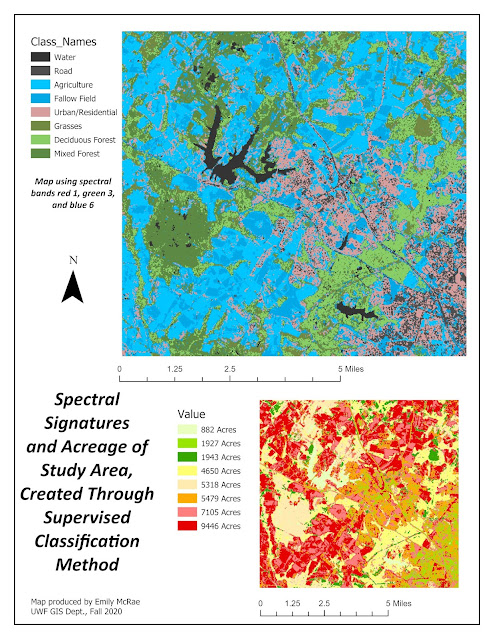GIS 5935 Module 6
This lab explores the complexities in representing real geographic phenomena accurately, both in terms of physical features and socioeconomic or other patterns, based on decision made by the cartographer. It looks at the distortions that can occur when data are displayed at varying scales, resolutions, and the very interesting and perplexing issue of the modified area unit problem (MAUP). The MAUP is an of yet, unsolved issue in spatial analysis, by which aggregation at different boundaries can yield very different results for analysis. This can even be exploited with gerrymandering, a practice of drawing political boundaries to intentionally to group voters and representation in favor of a political party.
This lab looked at the affects of scale on vector data, resolution on raster data, and measuring the degree of gerrymandering in congressional districts within the contiguous US. I will briefly detail the analysis process for each, and provide examples and explanations of the findings.
Scale
The example of scale applied here in terms of physical features on Earth; rivers and bodies of water. This was looked at both in terms of lines and polygon vector features. A river line feature and lake polygon feature were displayed at three scales, 1:1200, 1:2400, and 1:100000. Generally, in both the rivers and lakes, as the scale got smaller, the number of features increased. However, there was actually a bit more smoothing of features, such as rounder bodies of water or straighter lines for rivers. As the scale got larger, the number of features generally decreased, but there was some added detail to the shape of those features. Examples of this can be seen in the images below.
Resolution
The pixel resolution from a DEM of terrain was analyzed at 6 levels, and details about the slope were measured. Generally, as resolution decreased, the reported slope also decreased. A table and chart below show the results of these resolutions on the reported slope of the terrain.
Gerrymandering
Gerrymandering is the practice of drawing political boundaries in such a way that it favors the outcome of political parties. To combat this, it is recommended to compactness and contiguity when drawing the boundaries, as well as other features about the community contained within (Morgan and Evans, 2018).
In this example, only compactness was looked at.
To determine the compactness of the districts, I used the Polsby-Popper
(PP) test. This measure indexes the general compactness of the area of the district
based on its size and perimeter (Manley, 2014). It can be calculated with the following
formula:
PP score of district
= (4 π * area) / perimeter^2
To calculate this for each district, I added three fields to
the data set: area in square miles, perimeter in miles, and the PP score. I
calculated the geodesic geometry for the area and perimeter, ensuring the same projection
was used for each. I then plugged the formula into the PP field. This yields a
result for each, ranging from 0 to 1. To identify the worst 5, I sorted the PP
column in ascending order, and the first five results contain the lowest PP
scores.
Congressional districts 12, 3, 5, 1, and 7 have the lowest
scores in the continental US. The image below shows district 12, which has the lowest PP score in the contiguous US, at .029.
Sources:
Morgan, J.D. and Evans, J.
(2018). Aggregation of Spatial Entities and Legislative Redistricting (Links
to an external site.). The Geographic Information Science &
Technology Body of Knowledge (3rd Quarter 2018 Edition), John P. Wilson (Ed.).
DOI:10.22224/gistbok/2018.3.6
Manley, D. 2014. Scale, aggregation, and the Modifiable
Areal Unit Problem. In: Handbook of Regional Science, pp 1157-1171. Springer.
Dark, S.J. and D. Bram. 2007. The modifiable areal unit
problem (MAUP) in physical geography. Progress in Physical Geography, 31(5),
471-479
Crisman, Karl-Dieter, and Jones, Michael A. 2013 The Mathematics
of Decisions, Elections, and Games







Comments
Post a Comment